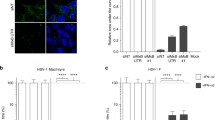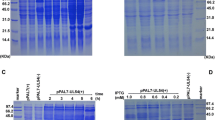Summary
Had-2, a mouse mutant cell line derived from FM3A, constitutively releases interferon-α and β and acquires resistance to Newcastle disease virus (NDV) and other viruses. However, Had-2 was found as susceptible to Sendai virus (HVJ) as FM3A. Even when Had-2 cells were infected simultaneously with NDV and HVJ, only the replication of NDV was inhibited, while that of HVJ was not. Northern blot hybridization analysis indicated that accumulation of NDV-specific primary transcripts was somewhat reduced in Had-2, but the reduction was insufficient to critically suppress the viral replication. Moreover, this decrease was not observed in the presence of cycloheximide, and a closely comparable amount of the primary transcripts was detected in both Had-2 and FM3A cells. The mRNA accumulated in the presence of cycloheximide was translated efficiently on removal of the inhibitor in FM3A cells, but not at all in Had-2 cells. Thus the translation of NDV mRNA was the major target of interferon in Had-2 cells. The fact that the synthesis of HVJ proteins was unaffected in Had-2 cells may imply that a host-cell component that distinguishes between NDV and HVJ mRNAs is involved in their translation.
Similar content being viewed by others
References
Aoki K, Oh-hira M, Hoshino M, Kawakita M (1994) Isolation and characterization of a novel mutant mouse cell line resistant to Newcastle disease virus: constitutive interferon production and enhanced interferon sensitivity. Arch Virol 139: 337–350
Balducci M, Verani P, Balducci D (1963) Assay of interferon activity. Appl Microbiol 11: 310–314
Beattie E, Tartaglia J, Paoletti E (1991) Vaccinia virus-encoded elF-2α homolog abrogates the antiviral effect of interferon. Virology 183: 419–422
Black TL, Safer B, Hovanessian A, Katze MG (1989) The cellular 68000-Mr protein kinase is highly autophosphorylated and activated yet significantly degraded during poliovirus infection: implications for translational regulation. J Virol 63: 2244–2251
Burke DC, Isaacs A (1960) Interferon: relation to heterologous interference and lack of antigenicity. Acta Virol 4: 215–219
Cayley PJ, Davies JA, McCullagh KG, Kerr IM (1984) Activation of the ppp(A2′p)nA system in interferon-treated, herpes simplex virus-infected cells and evidence for novel inhibitors of the ppp(A2′p)nA-dependent RNase. Eur J Biochem 143: 165–174
Chirgwin JM, Przybyla AE, MacDonald RJ, Rutter WJ (1979) Isolation of biologically active ribonucleic acid from sources enriched in ribonuclease. Biochemistry 18: 5294–5299
Colamonici OR, Domanski P, Sweitzer SM, Larner A, Buller RML (1995) Vaccinia virus B18R gene encodes a type I interferon-binding protein that blocks interferon α transmembane signaling. J Biol Chem 270: 15974–15978
Davies MV, Chang H-W, Jacobs BL, Kaufman RJ (1993) The E3L and K3L vaccinia virus gene products stimulate translation through inhibition of the double-stranded RNA-dependent protein kinase by different mechanisms. J Virol 67: 1688–1692
Davies MV, Elroy-Stein O, Jagus R, Moss B, Kaufman RJ (1992) The vaccinia virus K3L gene product potentiates translation by inhibiting double-stranded-RNA-activated protein kinase and phosphorylation of the alpha subunit of eukaryotic initiation factor 2. J Virol 66: 1943–1950
Friedman RM (1977) Antiviral activity of interferons. Bacteriol Rev 41: 543–567
Hallum JV, Thacore HR, Youngner JS (1970) Factors affecting the sensitivity of different viruses to interferon. J Virol 6: 156–162
Hoshino M, Taira H, Hattori S, Kawakita M (1987) The target reaction in the antiviral action of mouse interferon against vesicular stomatitis virus multiplication. J Biochem 101: 685–694
Isaacs A, Lindenmann J, Valentine RC (1957) Virus interference. II. Some properties of interferon. Proc R Soc London Biol 147: 268–273
Ishida N, Taira H, Omata T, Mizumoto K, Hattori S, Iwasaki K, Kawakita M (1986) Sequence of 2617 nucleotides from the 3′ end of Newcastle disease virus genome RNA and the predicted amino acid sequence of viral NP protein. Nucleic Acids Res 14: 6551–6564
Katze MG (1992) The war against the interferon-induced dsRNA-activated protein kinase: can viruses win? J Interferon Res 12: 241–248
Katze MG, DeCorato D, Safer B, Galabru J, Hovanessian AG (1987) Adenovirus VAI RNA complexes with the 68000 Mr protein kinase to regulate its autophosphorylation and activity. EMBO J 6: 689–697
Kerr IM, Stark GR (1992) The antiviral effects of the interferons and their inhibition. J Interferon Res 12: 237–240
Kitajewski J, Schneider RJ, Safer B, Munemitsu SM, Samuel CE, Thimmappaya B, Shenk T (1986) Adenovirus VAI RNA antagonizes the antiviral action of interferon by preventing activation of the interferon-induced elF-2α kinase. Cell 45: 195–200
Lee TG, Tomita J, Hovanessian AG, Katze MG (1990) Purification and partial characterization of a cellular inhibitor of the interferon-induced protein kinase of Mr 68000 from influenza virus-infected cells. Proc Natl Acad Sci USA 87: 6208–6212
Muñoz A, Carrasco L (1984) Action of human lymphoblastoid interferon on HeLa cells infected with RNA-containing animal viruses. J Gen Virol 65: 377–390
O'Malley RP, Mariano TM, Siekierka J, Mathews MB (1986) A mechanism for the control of protein synthesis by adenovirus VA RNA1. Cell 44: 391–400
Omata-Yamada T, Hagiwara K, Katoh K, Yamada H, Iwasaki K (1988) Purification of the Sendai virus nonstructural C protein expressed inE. coli, and preparation of antiserum against the purified C protein. Arch Virol 103: 61–72
Pestka S, Langer JA (1987) Interferons and their actions. Annu Rev Biochem 56: 727–777
Richman DD, Wong KT, Robinson WS, Merigan TC (1970) Effect of interferon on the replication of Sendai virus. J Gen Virol 9: 141–150
Samuel CE (1988) Mechanisms of the antiviral action of interferons. Prog Nucleic Acid Res Mol Biol 35: 27–72
Samuel CE (1991) Antiviral actions of interferon: interferon-regulated cellular proteins and their surprisingly selective antiviral activities. Virology 183: 1–11
Sen GC, Lengyel P (1992) The interferon system: a bird's eye view of its biochemistry. J Biol Chem 27: 5017–5020
Shibuta H, Kanda T, Adachi A, Yogo Y (1979) Characterization of bovine parainfluenza virus type 3. Microbiol Immunol 23: 617–628
Shioda T, Hidaka Y, Kanda T, Shibuta H, Nomoto A, Iwasaki K (1983) Sequence of 3687 nucleotides from the 3′ end of Sendai virus genome RNA and the predicted amino acid sequences of viral NP, P and C proteins. Nucleic Acids Res 11: 7317–7330
Stewart WE II, Scott WD, Sulkin SE (1969) Relative sensitivities of viruses to different species of interferon. J Virol 4: 147–153
Strube M, Bodo G, Jungwirth C (1985) Sensitivity of ortho- and paramyxovirus replication to human interferon α. Mol Biol Rep 10: 237–243
Su Y-H, Oakes JE, Lausch RN (1990) Ocular avirulence of a herpes simplex virus type 1 strain is associated with heightened sensitivity to alpha/beta interferon. J Virol 64: 2187–2192
Su Y-H, Oakes JE, Lausch RN (1993) Mapping the genetic region coding for herpes simplex virus resistance to mouse interferon α/β. J Gen Virol 74: 2325–2332
Symons JA, Alcami A, Smith GL (1995) Vaccinia virus encodes a soluble type I interferon receptor of novel structure and broad species specificity. Cell 81: 551–560
Taira H, Ranin L, Iwasaki K (1990) Construction of expression plasmids for the fusion protein of Sendai virus, and their expression inE. coli cells and eucaryotic cells. FEBS Lett 262: 39–41
Takeishi K, Ayusawa D, Kaneda S, Shimizu K, Seno T (1984) Molecular cloning of genomic DNA segments partially coding for human thymidylate synthase from the mouse cell transformant. J Biochem 95: 1477–1483
Yu Z, Gotoh B, Hamaguchi M, Nagai Y (1995) Antiviral action of interferon-β on Newcastle disease virus: selectivity to the hemagglutinin-neuraminidase gene expression. Med Microbiol Immunol 184: 45–52
Author information
Authors and Affiliations
Rights and permissions
About this article
Cite this article
Aoki, k., Kawakita, M. Differential sensitivity of two related viruses, Newcastle disease virus and Sendai virus, to interferon in mouse Had-2 cells: selective inhibition of translation of NDV mRNA. Archives of Virology 141, 1847–1862 (1996). https://doi.org/10.1007/BF01718199
Received:
Accepted:
Issue Date:
DOI: https://doi.org/10.1007/BF01718199




